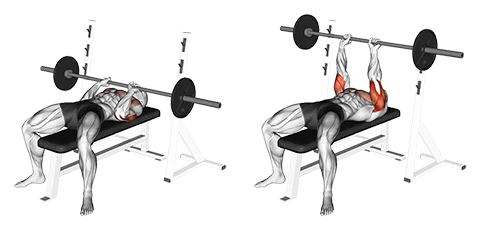Introduction
The barbell bench press close grip is a weightlifting exercise targeting the chest muscles. It primarily strengthens and develops the inner part of the pectoralis major muscle group. By focusing on this area, this variation of the traditional bench press can help build a more defined and balanced upper body physique. Its effectiveness lies in its ability to isolate the inner chest, making it ideal for those with specific fitness goals centered around improving chest definition and strength.
Muscles Worked
- Primary: Chest (Pectoralis Major), Triceps (Triceps Brachii)
- Secondary: Shoulders (Deltoids), Core (Abdominal and Lower Back Muscles)
How to Do It (Step-by-Step)
- Position the barbell on a power rack at a comfortable height with a shoulder-width grip (slightly closer than usual). Lie on the bench beneath the barbell with your feet flat on the floor.
- Unrack the barbell, hold it close to your shoulders, keeping your elbows tucked in. Lower the barbell slowly until it nearly touches your chest.
- Maintain a tight core, keep your back arched, and avoid flaring your elbows out during the lift. Push the barbell back up by extending your arms fully, and repeat the movement for desired reps.
Tip: Keep your wrists in a neutral position throughout the exercise to prevent unnecessary strain and promote better form.
Rep & Rest Guidelines
- Strength: 4–6 reps, 2–3 min rest
- Hypertrophy: 8–12 reps, 60–90 sec rest
- Endurance: 12–20 reps, 30–60 sec rest
Using Auto Progression in Volym can help optimize your workouts for continuous improvement.
The Rest Timer in Volym ensures you take the right amount of rest between sets, maximizing your performance and recovery.
Form Tips
- Maintain a narrow grip (shoulder width or slightly narrower) to focus more on the triceps and inner chest muscles.
- Keep elbows close to the body during the entire movement for better control and engagement of the triceps.
- Lower the bar slowly and controlled, touching it just below the chest to ensure maximum muscle activation and prevent injury.
When to Use It
- Building upper chest and inner deltoids (clavicular head)
- Increasing pressing strength for Olympic weightlifting movements like the push press and jerk
- Improving pushing power and stability during sports that require overhead movement, such as volleyball or swimming
Workout History can help you track your progress with barbell bench press close grip exercises and other workouts over time.
The triceps, shoulders, and chest muscles are primarily targeted.
A close grip narrows the hand position on the barbell, focusing more on triceps engagement.
Typically, a grip between 2-3 inches is considered close-grip.
Yes, it can help build greater triceps strength and improve pressing power.
Both types of bars work, but an Olympic bar might be more comfortable due to its knurling pattern.

